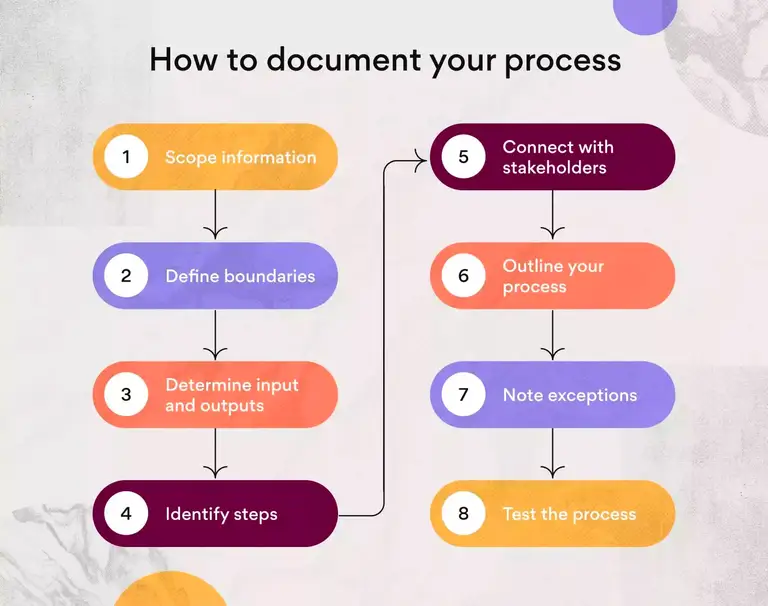When you want to up productivity in the workplace and ensure that projects are completed at a high quality and on time, every time, it may be worthwhile to implement a new protocol into your teams.
One great solution that has grown in popularity in recent years is process documentation. So let’s take a look at how to write a business process documentation for maximum results. Besides process knowledge, you'll also need a bit of extra knowledge to create a visual representation of how things are done.
Let's help you do just that.
What is process documentation?
Process documentation is where all the aspects of a business project are collected within one process documentation template as and when each step is completed, to form an easy to digest, step-by-step guide for employees to follow in the future.

As it is editable and filled out in real-time, the documenting processes will allow for deep insights into what methods are working and what areas can be improved, as well as minimize the work that HR has to execute.
Process documentation examples include:
- Content editing and publishing guidelines
- Employee onboarding checklists
- Equipment inspection and maintenance procedures
- Customer support guides
- Billing and collection of documents
- Performance review guidelines
While these are all different types of documents, they have a few things in common. Each of them has process boundaries and process maps that need to be followed, and an accurate and easy to understand visual representation of the process.
Six tips on how to create process documentation
Document processing may sound time intensive, but the reality is that the final product can speed up future functionality and improve overall workplace productivity. Here are 6 tips to get the most out of your process documentation with proper standard operating procedures in place:
- Consult your employees to determine any pain points they may have with the way things currently function
- Set actionable goals at the start of the project to ensure that any employee needs brought up at consultation are met
- Set the start and end dates of the process document to ensure everyone works to clearly defined deadlines
- Build a strong team, as process documentation will provide the best results when everybody involved contributes
- Appoint a writer for each department to vet unnecessary information and keep steps short and succinct
- Establish a review and approval process to monitor and improve future process documentation

Five useful tools for process documentation
Here are the top 5 useful tools for creating well-documented processes, but of course there are many more out there.
- Microsoft Word
- Microsoft Visio
- Lucid Chart
- Gliffy
- Smart Draw
Making use of an employee scheduling app could also be of benefit during process documentation. An app such as Unrubble helps you with process optimization. You can see all the process roles and who does which task, at which point in time.
You can use this for continuous improvement and to remove process bottlenecks. It also allows you to create accurate process documentation, since you'll know how much time and effort key processes take.
Benefits of process documentation
Not only can process documentation play a pivotal role in workplace productivity, but there are a host of other benefits on offer, such as:
Improved processes: In many projects there will be exact steps that are simply unnecessary, but they can be hard to define when everything functions as usual. When you properly document the processes involved, it will be easier to see what is relevant and irrelevant.
This form of documentation helps you find out if you're wasting time and money on an unnecessary process step. You can decrease costs and reduce operational damage, all while creating a culture of transparency.
Better staffed teams: Often, teams will be assigned to projects as a whole, so there may be times when certain employees’ skills are not necessary, or you could do with additional expertise from another department. Process documentation can ensure you have the right staff for every project moving forward.
Team leaders will know when to assign individual employees and for which tasks. Employee productivity will improve too. You'll identify key stakeholders for each task and thanks to proper resource allocation, you'll always have just enough people to get things done.
Minimal confusion: With process documentation, everyone will have their tasks clearly defined and will be clear on the expectations placed on them for the task ahead. Once everything is completed, future teams and even new employees will be able to get on with little downtime.
The preservation of information: There will be instances when a member of the team will have expert knowledge on specific project processes, but what happens when they’re unavailable, or worse, they leave? Important information would typically be lost, but with process documentation, everything will be easily accessible no matter what the future holds.
Better analysis: Process documentation will allow companies to better determine if new processes work better than old ones, even if the methodologies are completely different. This can help to define and troubleshoot flaws, streamline HR reporting, reduce downtime, and even save on a host of costs per project.
Enhanced communication: One of the top benefits of process documentation is the fact that communication between teams will be simpler and more streamlined and shareholders will be able to log in to one portal and access the project at any time. Less confusion and real-time feedback will minimize mistakes and improve work quality, all while keeping everyone up to date in real time.
Roles in process documentation
Business process documentation typically involves:
The project team: these will be responsible for the main components of the documentation process. When it becomes natural to take notes during work, the team will become more aware of the effort they are putting in and will be consistently learning on the job.
If you feel like the process may take away from productivity, you can always appoint a specialist to undertake the documenting role instead. They can document each process step with specialized process documentation tools.
The stakeholders: this refers to any individual or organization that is involved in the project. When they are included in the documenting processes, they will have the ability to give feedback and provide worthwhile suggestions that will help to ensure the quality of the final product.
Make sure to include job titles, as this will make it easy to visualize complex processes. When a job title is tied to process tasks, this can lead to process improvement over time. Simply put, you'll know who is in charge of each step of the entire process. In fact, process documentation software may even require job titles.
Any necessary external parties: sometimes it will be a good idea to invite third parties into your process documentation to provide unbiased opinions and fair judgment of how everything is progressing. Sometimes, a fresh set of eyes can pinpoint issues that you and your team may otherwise overlook.
Unlike process owners, they can give you a fresh look at your organizational processes and help create effective process documentation.
Key considerations when writing a process documentation
When you decide to write process documentation, it can be imperative to achieve a worthwhile balance between a thorough, detailed guide and a clear, well-thought-out piece that gets the point across with little fuss.
The best way to achieve this is to define the exact information you need and omit anything that may be considered off-topic. You should always keep the audience in mind, as those receiving the final document may not have the same knowledge or skills as you do.
If you think certain information will be helpful but potentially a little too complex, there may be better ways to incorporate it than blocks of text (like images, for example).
If you are going to be sharing your process documentation with shareholders or other third parties, consider if you want to include the motivation and goals for the project, so that they will better understand its purposes and why certain tasks are being undertaken and when throughout the project.
Wrapping up
Documenting your processes helps you create a single source of truth for your company. Whether it's technical documentation or simple office rules, having step by step instructions in a centralized location helps with everyday operations.
And if you're looking for another way to refine your current processes without a lot of heavy lifting - try time tracking! With Unrubble, you can improve your employee satisfaction with just one simple process - using a time tracking tool.





